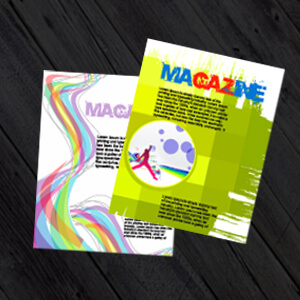In an era dominated by digital marketing strategies, the resurgence of print as a powerful communication tool might seem counterintuitive. Yet, as businesses navigate an increasingly crowded online landscape, the tangible and tactile nature of print marketing offers a refreshing and effective alternative. Here’s why, now more than ever, businesses should be turning to print as their main form of marketing communications.
1. Cutting Through the Digital Noise: In an age where consumers are bombarded with a constant stream of digital advertisements, emails, and social media posts, print materials stand out by offering a physical presence in a world of virtual distractions. A well-designed print ad or brochure has the power to capture attention in a way that digital content often struggles to achieve.
2. Building Trust and Credibility: Despite the convenience and immediacy of digital communication, many consumers still view print materials as more trustworthy and credible. A professionally printed brochure or direct mail piece conveys a sense of legitimacy and permanence that can help to establish a stronger connection with potential customers.
3. Targeted and Personalised Messaging: Print marketing allows businesses to tailor their messaging to specific demographics or target audiences in a highly personalised manner. From customised direct mail campaigns to niche magazine advertisements, print materials can be strategically deployed to reach the right people at the right time, driving higher engagement and conversion rates.
4. Enhanced Brand Recall: Research has consistently shown that print advertisements tend to have a longer-lasting impact on consumer memory compared to digital ads. The tactile experience of holding a physical piece of marketing collateral can create a stronger emotional connection with the brand, leading to greater brand recall and recognition over time.
5. Complementing Digital Strategies: Rather than viewing print and digital marketing as competing channels, businesses can leverage the strengths of both mediums to create integrated marketing campaigns that maximise impact. By combining print materials with online elements such as QR codes or personalised URLs, businesses can enhance the effectiveness of their marketing efforts and provide consumers with a seamless omni-channel experience.
6. Sustainability and Eco-Friendliness: Contrary to common misconceptions, print marketing can be an environmentally sustainable option when produced responsibly. Many printing companies now offer eco-friendly materials and processes, including recycled paper and soy-based inks, allowing businesses to reduce their carbon footprint while still harnessing the power of print advertising.
7. Tangible Brand Experience: In an increasingly digital world, the physical experience of interacting with print materials can help to create a memorable and lasting impression on consumers. Whether it’s a beautifully designed brochure, a high-quality magazine advertisement, or a creative direct mail piece, print marketing offers businesses the opportunity to engage their audience in a tangible and immersive way.
In conclusion, while digital marketing undoubtedly has its place in today’s business landscape, the timeless appeal of print should not be overlooked. By embracing print as a key component of their marketing strategy, businesses can cut through the digital noise, build trust and credibility, deliver targeted messaging, enhance brand recall, complement digital efforts, promote sustainability, and create a tangible brand experience that resonates with consumers on a deeper level. For all your printing needs visit PrintUK.com







.jpg)
.jpg)
